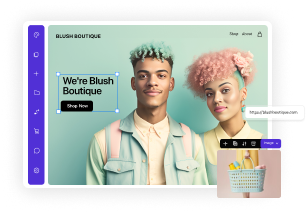What Is A Blog? Definition, Types, & Why You Should Start One In 2025
Updated Feb 25, 2025 | Published Dec 12, 2024 | 16 min read

Creating a blog is a popular way for individuals and businesses to share their unique perspectives on areas of expertise and foster relationships with an online community.
Understanding what a blog is can help you deliver the best possible content for optimal audience engagement and ensure your website achieves the best search engine results.
This guide covers all aspects of blogging, from the many blog types people create to the key elements each blog should include to stand out from the competition.
A blog is a type of website content that offers valuable insights into various topics, from personal hobbies and interests to business products and services.
Blogging, a combination of the words “web” and “log,” began as an online diary where people discussed their lifestyle habits and other activities readers showed an interest in.
Over time, blog writing has evolved to meet various business demands as a core element of a company website for improving search engine optimization and building customer relationships.
This includes functioning as a powerful tool for marketing and brand awareness and providing high-quality blog content that informs potential customers about the core business goals.
With hundreds of millions of blogs worldwide and growing, the future of blogging will remain a key fixture for individuals and organizations cementing their online presence.
Create a blog with Friday.
Whether you’re creating blogging as a side hustle or considering incorporating business blogs into your company website, all blogs include several key elements to achieve their goals.
Here’s a breakdown of the main blog post elements you need to consider to create blogs that clearly present information and reach your target audience.
An engaging headline or blog post title is the first thing any potential readers will see, so it needs to be instantly engaging and capture the essence of the content.
Writing a great headline is crucial for engagement, giving a preview of the personal stories or an informative overview of a topic to help the reader decide if they want to proceed.
As such, they should be concise and to the point, with attention-grabbing phrases, and include high-valuable keywords that will perform well on search engines.
Once you’ve composed an eye-catching headline, the next step in creating a blog post is to write the content, which forms the meat of the post.
Frequently used blog content formats include opinion pieces, news articles, top lists, and how-to articles that help readers accomplish a specific task.
Each blog post should include well-spaced headers to break up the body text, as well as bullet lists, tables, and other formatting elements as and when required.
To help readers navigate other relevant web pages, blog posts should be appropriately categorized to assist with site navigation and functionality.
Including high-quality images, such as photographs or illustrations, is another essential element to delivering a successful blog that engages readers.
Personal blog owners frequently share their photos to add greater value to their text, particularly for content such as food, travel, and visually interesting hobbies.
You don’t have to set up an artist website to include visual elements; if you lack any, you can find free-to-use images online.
Most blogs have a sidebar adjacent to the main body of text for each post, allowing visitors to navigate to other core pages on the site easily.
A blog site sidebar can include the following features:
Adding and editing these sidebar elements in a website builder is incredibly easy, with different features dragged and dropped into place in the builder’s editor.
Allowing blog post readers to add comments and engage with one another is another core element of a typical blog’s format.
This section, which appears beneath the main body text of each blog post, is easy to enable and helps genuine readers respond to your personal commentary and share their insights.
While legitimate concerns about spamming and toxic behavior exist, many AI-powered tools are available to help manage comment section moderation and keep conversations on-topic.
Lastly, a typical blog post finishes with a footer section, which includes basic copyright information, privacy policy links, and terms of service.
Navigation links to the site’s main web pages are also included here, along with the company’s logo and other key elements to reinforce the business or personal brand identity.
Most blogging software includes this section in the blog post template, so you can edit it to your preferences before you launch the blog to the public.
With millions of blogs on the Internet, there’s no shortage of topics covered in detail, whether it’s a popular personal blog or a blog promoting corporate goals.
These are some of the most popular types of blogs you can research before you start writing your own blogs:
These are just a few examples of blogs that can be set up to attract customers or reach out to like-minded people who share your hobbies and interests.
Likewise, the types of businesses that can benefit from setting up business blogs to share details of their products and drive traffic to their entire websites are unlimited.
Use professional templates with Friday.
Now that we’ve answered the question, “What is a blog?” and broken down the key elements that all blogs should include, let’s explore why setting up a blog is essential to consider.
Once you’ve selected a web hosting service with a robust content management system, you can start blogging and enjoy the many benefits it has to offer:
The first and most common benefit of creating blogs is sharing your unique insights into your chosen area of expertise and gathering feedback from like-minded readers.
This benefit applies to all blog types, whether you’re promoting a new social entrepreneurship idea or writing a tech blog covering the latest software and gadgets.
Engaging with your target audience allows you to constantly learn new things and improve your understanding of a topic, enabling you to write blogs that deliver exceptional value.
The ability for readers to comment on each blog post fosters and develops robust communities with a shared interest in communicating certain ideas.
Over time, bloggers can build strong relationships with their audience, discussing everything from solopreneur business ideas to the latest advice on travel safety.
Through these relationships, like-minded people can be invited to write a guest post on a topic, adding value to blogging’s community-building essence.
If you run a business website selling products or services on a B2B or direct-to-consumer basis, blogging is essential for success.
Along with providing potential customers and clients with insights into the business’s core products and services, blogging helps improve visibility and strengthens competition with other websites.
This applies to all products or services, from major international businesses to individuals who engage in side hustles to pay off debt in their spare time.
In addition to driving traffic to other areas of a website that sell products or services, a blog can also become a distinct revenue generation stream in its own right.
Blog posts can be linked to a website’s online store, or earn money by placing advertisements for other companies directly in each blog post.
You can also monetize a blog by charging a subscription fee for exclusive member content, including purchasable training courses, and by working with affiliates for marketing initiatives.
Writing compelling blog posts and sharing content regularly is a core aspect of inbound marketing, which involves attracting and engaging audiences to convert them into leads and sales.
There are many reasons why blogs are important for businesses, with inbound marketing used to establish thought leadership and demonstrate value to potential customers.
With these strategies essential for small business marketing, setting up a blog is an affordable and reliable process that delivers exceptional results.
Another common reason individuals and businesses adopt blog content creation is to increase their website’s position in search engine rankings.
SEO is a core aspect of blogging, from researching relevant keywords for text to incorporating SEO-friendly tags on images and integrating internal and external links.
Once a blog post schedule has been determined and created, blogging can become a vital cog in the wheel of businesses that run themselves while delivering results.
There is considerable overlap in principles between a blog and a website, with blogs typically included as an element in a broader website for businesses.
A website takes a more general and far-reaching approach to online content and promotion, including primary landing pages such as home pages and others for specific services and information.
It includes dedicated assets such as calls to action and FAQs to help potential customers obtain the information they need to make an informed purchasing decision.
Websites can also include an online store to sell physical and digital products directly to consumers, saving the expenses of running brick-and-mortar stores.
Blogs provide additional support for these pages and features, complementing them through SEO and providing more detailed answers that basic FAQs can’t offer.
The importance of websites that include blogs is likely to increase over time, with the rise of Internet users and the growth of services such as Starlink reaching all corners of the world.
Related reading: Learn how to make a business website.
If you’ve enjoyed reading blogs on other websites and are considering writing your own blogs, there are a few steps you need to be aware of before you begin.
Understanding these steps is vital for planning and creating a blog that delivers the results you’re hoping for and has the potential for long-term growth.
It can also help you determine which freelancer tools can be applied to your workflow and allow you to create a blog that looks and performs as intended.
So, let’s break down the key steps you need to follow when creating a blog:
As with many other creative activities, blogging is a process that evolves as you develop new skills, with careful analysis allowing bloggers to refine and improve their strategy.
Before you launch a blog, you should be clear on the pros and cons of blogging to help you make an informed decision and approach the content correctly.
It can be as simple as sharing your recent vacation experiences with friends and family or discussing new trends in gaming and other activities.
Starting a blog can be a vital marketing and customer engagement resource for businesses, provided you can post regularly and respond to comments.
Once you have a successful blog, it can also provide a launchpad for blogging jobs on other platforms, paving the way for a career as a freelance writer.
Once your blog is up and running, it’s time to create promotional campaigns to help it reach your target audience and attract the engagement it deserves.
Let’s break down the various ways to promote your blog using your social media presence and other strategies designed to enhance audience engagement.
There’s no limitation on which approach you can adopt for blog promotion, and assessing the results for each method will help you refine the process in the future.
You can also explore a broad selection of free sites for blog promotion, such as Quora, Reddit, and Medium, which will further improve your online reach.
These platforms also have the advantage of featuring active users who visit these sites to engage in conversations and share valuable opinions and feedback.
Start blogging with a Friday subscription.
Blog content is increasingly popular for individuals and businesses looking to reach their target audience and increase their ranking in search engine results pages.
Following the information in this article will help you to make an informed decision about creating the best blog for your needs and regularly posting new blog posts that drive engagement.
As your blog becomes more popular, you can use it to generate additional revenue streams by selling digital or physical products to customers or earning income through advertisements.
